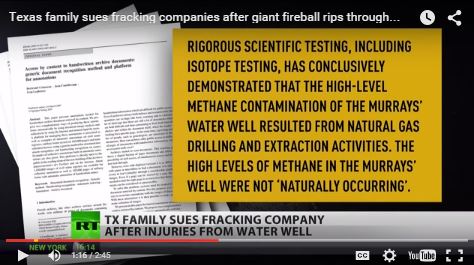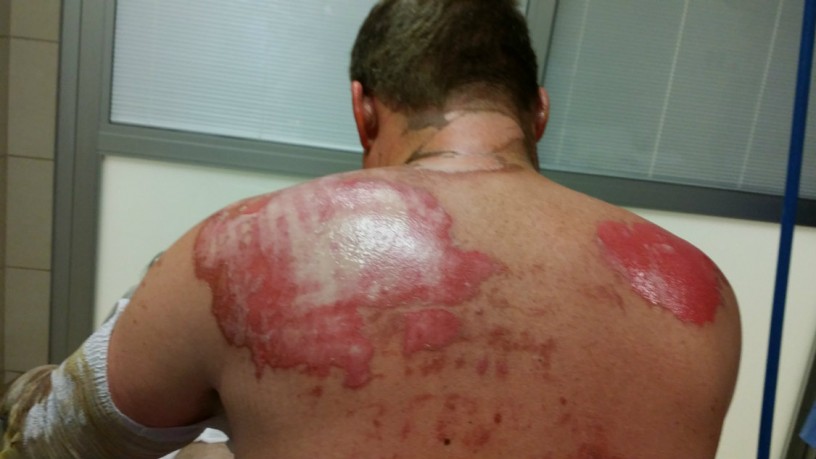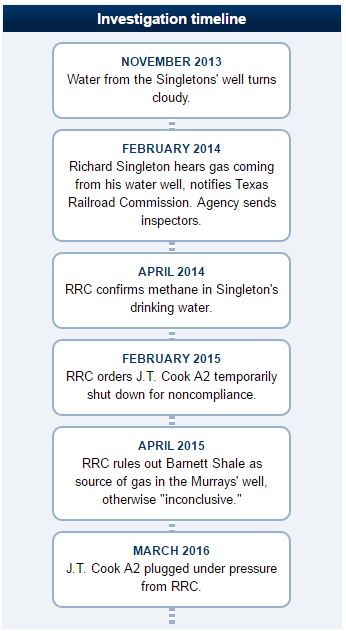Texas officials found 50 cases of groundwater contamination in 2015 by Mike Soraghan, September 6, 2016, E & E News
Russell Ray called Texas officials last year because he suspected the oil and gas wells surrounding his home in Lubbock made his drinking water salty and left it full of what he called “crud.”
His was one of 50 cases of groundwater contamination from oil and gas operations documented in 2015 by the Texas Railroad Commission, the agency that oversees oil and gas in the state.
Overall, the state is dealing with 570 cases of groundwater contamination from oil and gas operations, according to the 2015 “Joint Groundwater Monitoring and Contamination Report,” released last week by the Texas Groundwater Protection Committee. The report compiles cases from several state agencies.
The 50 new oil field cases in 2015 represent a slight increase over 48 the year before but are down substantially from 72 in 2013, at the height of the boom.
Groundwater contamination has been cited as one of the chief risks of the country’s oil and gas boom, driven by advances in hydraulic fracturing. The oil and gas industry and state officials who regulate it have consistently said there are few cases of groundwater contamination from fracking, if any. [In Alberta in 2006, when Ernst went public with her contaminated water and Encana breaking the law fracturing her community’s drinking water aquifers, companies, politicians, synergy groups and regulators loudly and proudly announced that the oil and gas industry had never contaminated groundwater anywhere!]
But there are many ways oil and gas production can affect groundwater, beyond fracking. Pipelines break, faulty well construction allows “stray” gas to rise into aquifers, and surface spills release salts and chemicals that seep underground.
Fracking is a relatively brief part of well construction in which chemical-laced water and sand are injected down the hole at high pressure to crack open rock and release oil or gas.
U.S. EPA released a draft study last year saying there aren’t “widespread, systemic” problems for drinking water from fracking. The agency’s science advisers have criticized that conclusion as vague and unsupported by the research (EnergyWire, Aug. 12).
The spills occurred at oil and gas wells, waste disposal sites, and gas plants and along pipelines, according to the list of contamination sites.
The list does not include the site of a 2014 water well explosion in Palo Pinto County, where Texas Railroad Commission officials found thermogenic gas originating from the deep layers from which companies produce gas. The explosion injured a rancher, his father and his daughter (EnergyWire, June 1).


Cody Murray’s injuries after his methane contaminated water well exploded

State tracking systems differ
Other oil and gas states track groundwater contamination. But each does it in different ways.
Colorado spill records indicate that producers themselves reported groundwater contamination in 92 cases last year. The Pennsylvania Department of Environmental Protection, based on complaints from residents, confirmed 26 instances in 2015 in which oil and gas had damaged water supplies.
Critics of regulators in Pennsylvania, Texas and other states say there are many more cases of such contamination. They say state oil and gas officials ignore or miss signs of contamination and are too reluctant to blame operators for contamination.
Texas Railroad Commission spokeswoman Ramona Nye rejects such criticism, saying the agency protects public safety and the environment “by maintaining a strong regulatory framework for the energy industry to follow.” [By constantly deregulating to enable the contamination and harms, like Alberta’s AER consistently does?]
She added that “commission records do not indicate a single documented groundwater contamination case associated with the process of hydraulic fracturing in Texas.”
[Shred Cross Check: Frac contamination cases filed by burning or shredding like in Alberta?

Attempts to reach Ray on Friday were unsuccessful. But he told the Lubbock Avalanche-Journal newspaper in 2014 that he got his water tested with the help of a local advocacy group called the West Texas Accountability Project.
He said guests in his home told him the water tasted funny. He didn’t taste it, he said, because he’d become accustomed to it.
What bothered him was the “crud” that settled in drinking water glasses.
Water tests showed the water had a high chloride count of 1,280 milligrams per liter. EPA’s recommended maximum for chloride in drinking water is 250 mg/L.
In water contamination cases, oil and gas producers often say homeowners are unfairly blaming them for existing water quality problems. That’s the case for Ray also. Tamarack Petroleum Co. Inc. of Milwaukee, which operates the wells in the area, said groundwater in the area is generally of poor quality.
“There’s no indication that our well has anything to do with any problems with his water,” Tamarack President Deborah McKeithan said in an interview Friday. “The water is terrible all over the place out there.”
A Railroad Commission inspector checked the site in January, McKeithan said. He didn’t find “any violations of statewide rules nor evidence indicative of oil field contamination,” she said, reading from Railroad Commission correspondence.
The state contamination report states that it provides the status of “documented groundwater contamination reasonably suspected of having been caused by activities regulated by state agencies.”
In the case of the Railroad Commission, that is oil and gas operations. The Railroad Commission is one of 10 agencies that make up the Texas Groundwater Protection Committee, which issues the contamination report annually.
Click here for the “Joint Groundwater Monitoring and Contamination Report.”
Click here to download PDF version of an Excel spreadsheet of data on water contamination cases documented by Texas oil and gas regulators beginning in 2006.
[More information on the Murray family water well contamination and explosion:
